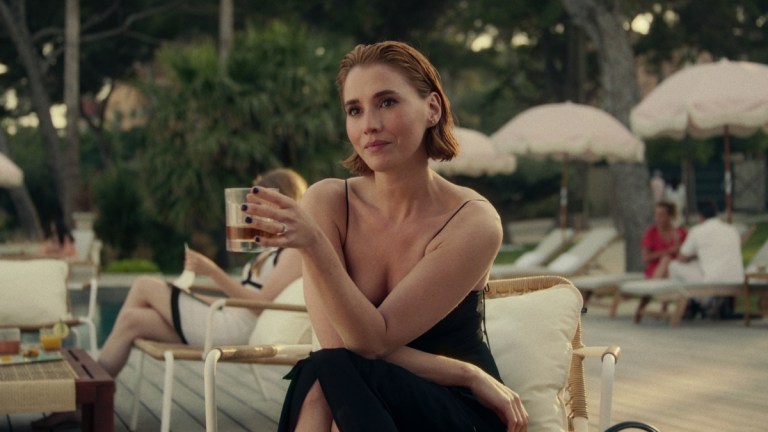Obsession Ending: Explaining Anna’s Final Scene and Changes From the Book
What did the therapist scene mean, and where does the Netflix erotic thriller differ from the novel?

Warning: contains major spoilers for the Obsession finale.
Netflix’s Obsession changes the ending of the Josephine Hart novel Damage, from which it was adapted, by choosing to shift the story’s focus away from the male lead (nameless in the novel, but named Will in the TV series and Stephen in the 1992 feature film) and onto the character of Anna Barton.
The TV series ends with Anna (Charlie Murphy) starting therapy, having decided to stop her destructive cycles and work through her traumatic past with a counsellor. In the final scenes of the series, she phoned her friend Peggy (not Will, as was teasingly suggested) to say “I need you”. Peggy helped Anna away from her London flat in which she’d conducted the affair with Will and where her fiance Jay – Will’s son – had died, and away from Anna’s dysfunctional relationship with her mother. After Jay’s death, Anna’s mother revealed that she knew Anna was being incestuously abused by her brother Aston as a child, but did nothing to stop it and even blamed Anna for Aston’s obsession with her and for his subsequent suicide.
In the therapist’s office, Anna looks as though she’s turned over a new leaf and is on a healthier path, but then a final moment of ambiguity threatens to undermine that resolve. Apologising to her male therapist for not really knowing “the rules”, he asks, “Would it help to have some rules, is that something you feel you need?” His words register with Anna and she says “How strange” with a slight disbelieving shake of the head followed by what looks like the start of a nod, cut off before the credits roll.
Anna’s history as a willing submissive in the BDSM sexual affair she had with Will adds significant subtext to the therapist’s suggestion that he could set her “rules”. Anna chose to surrender herself to Will’s control sexually and in life – asking him to choose her drinks and only agreeing to marry his son under his orders. The series appears to end on a pivotal decision for Anna – is she about to start the whole process again and submit to a new ‘master’ in her therapist, or will she end the cycle as intended?
The audience is left to decide whether Anna is still trapped in repeating behaviour or whether she will make the recovery she’s started upon.
Will’s ending in the TV series is much less ambiguous and much closer to that of his book and film counterparts. He’s not attempting to move on from his affair with Anna, but surrounding himself with it. Estranged from his ex-wife and daughter, Will is last seen sitting alone in Peggy’s empty former London flat – the site of his and Anna’s affair, and the building where his son fell to his death – where he now lives, with Anna’s ribbon-wrapped diary as a souvenir.
How Did the Book End?
Will and Anna’s final encounter in the Netflix series is very different to that in the novel. In both the book and the TV adaptation, Anna walks out on the night Jay (named Martyn in the book) dies after catching her having sex with his father, and disappears. That’s the last she’s heard from in the book apart from a letter she has delivered to the narrator, telling him not to look for her and that now he has his own pain, he’ll no longer hunger for hers.
In the book, the narrator has a final chance meeting with Anna at an airport a few years later. They don’t speak, but Anna walks up to him, removes his dark glasses and looks intensely at him. He falls to his knees in front of her, and she walks away as he collapses. As she goes, the narrator notes that Anna is pregnant and in the company of a small child and her ex Peter Calderon (a character whose role was either absent or remoulded into that of her friend Peggy in the TV series). Book-Anna has thrown her lot in with Peter and started a family.
The series’ scenes of Anna going on her honeymoon alone and attempting to lose herself in anonymous hedonistic sex before changing her mind and having to fight off the man she picked out of the crowd, were invented for the Netflix show, as was the scene of Will finding her at the hotel, bathing her wounds and telling her that he doesn’t regret their affair (he ran the bath for his wife Ingrid after their son’s death, and said the same thing in the book).
The book narrator ends the story living alone in a monastically furnished flat decorated with two bespoke photos of Anna blown up to an enormous size. He longs for death, knowing that his love story – as he is convinced it was – with Anna is truly over.
The 1992 feature film starring Jeremy Irons and Juliette Binoche in the narrator/Anna roles ended in much the same way to the book. Its final scene shows Irons’ character withdrawn from the world and living alone in a European city in a sparsely furnished apartment decorated with a huge scale photograph of himself, his son, and Anna. The final shot sees the camera zoom in closer and closer to the photograph until it’s completely obscured. The way the Netflix series reframes the ending, Anna is seen less as a fetishised object viewed through the narrator’s eyes and more as a character with her own – ambiguous – agency.
Obsession is out now on Netflix.
